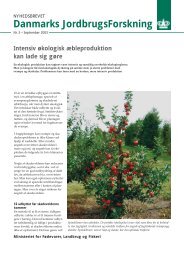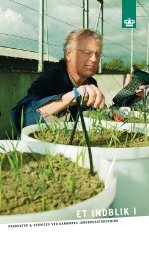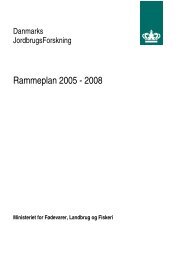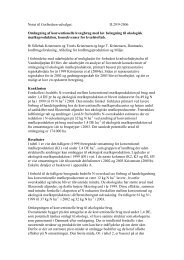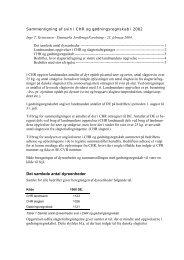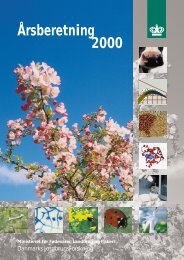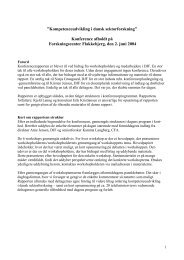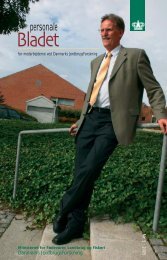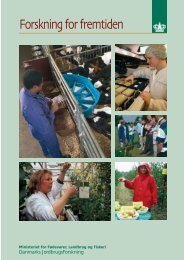Reproduction performances and conditions of group-housed non ...
Reproduction performances and conditions of group-housed non ...
Reproduction performances and conditions of group-housed non ...
You also want an ePaper? Increase the reach of your titles
YUMPU automatically turns print PDFs into web optimized ePapers that Google loves.
- Background <strong>and</strong> aim -<br />
BACKGROUND AND AIM<br />
For several decades, individual housing <strong>of</strong> <strong>non</strong>-lactating sows was preferred, probably because<br />
individual housing made it possible to control the individual sows access to important<br />
resources like feed <strong>and</strong> water. However, in the last decade the number <strong>of</strong> <strong>group</strong> <strong>housed</strong> <strong>non</strong>lactating<br />
sows has begun to increase in Europe. This is mainly caused by elevated public<br />
concern <strong>of</strong> animal welfare with changed legislations as a consequence. For instance, according<br />
to EU legislation all sows have, from January 2013, to be loose-<strong>housed</strong> in smaller<br />
or larger <strong>group</strong>s from four weeks after mating until seven days before expected farrowing<br />
(Council Directive 2001/88/EC amending Directive 91/630/EEC Laying Down Minimum<br />
St<strong>and</strong>ards for the Protection <strong>of</strong> Pigs). In addition, national extraordinary laws have been<br />
introduced in several countries. In Engl<strong>and</strong>, for instance, all sows have to be <strong>group</strong> <strong>housed</strong><br />
in the entire period from weaning to seven days before expected farrowing according to the<br />
national legislation (The welfare <strong>of</strong> Farmed Animals (Engl<strong>and</strong>) (Amendment) Regulations<br />
2003). In Norway, the sows may only be fixed from three days before until one week after<br />
farrowing, <strong>and</strong> in Sweden it is only allowed to keep sows in crates for maximum one week<br />
if necessary during the production cyclus (Baustad & Lium, 2002). Although no laws or<br />
regulations so far, similar tendencies are also seen in other parts <strong>of</strong> the world (McGlone,<br />
2001; Trezona, 2003).<br />
In Denmark it is still legal to keep the sows in crates from weaning until four weeks after<br />
mating. Nevertheless, the Danish Bacon <strong>and</strong> Meat Council, motivated by export interests,<br />
has introduced an extra pay for slaughter pigs produced by sows that are <strong>group</strong> <strong>housed</strong> in<br />
the entire <strong>non</strong>-lactating period. This additional price has caused an increase in the number<br />
<strong>of</strong> sows that are <strong>group</strong> <strong>housed</strong> from weaning to shortly before farrowing in Denmark.<br />
However, impaired reproduction in form <strong>of</strong> reduced litter size <strong>and</strong> pregnancy rate in <strong>group</strong><br />
<strong>housed</strong> compared to individual <strong>housed</strong> sows in parts <strong>of</strong> or in the entire <strong>non</strong>-lactating period<br />
has been observed in several Danish on-farm experiments. Sows <strong>group</strong> <strong>housed</strong> from weaning<br />
until two days after mating had significant fewer total born piglets compared to sows<br />
individually <strong>housed</strong> in the same period (Hansen, 2000). Sows <strong>group</strong> <strong>housed</strong> from weaning<br />
to farrowing had significant fewer total born piglets per litter than sows kept individually in<br />
crates the first four weeks after weaning <strong>and</strong> thereafter loose <strong>housed</strong> until farrowing<br />
(Fisker, 1995). Equally, in other countries a reduced farrowing rate has been seen in <strong>group</strong><br />
<strong>housed</strong> compared to individual <strong>housed</strong> sows (USA: Hurtgen et al., 1980; Finl<strong>and</strong>:<br />
Peltoniemi et al., 1999). Conversely, in other studies, no difference (conception rate <strong>and</strong><br />
litter size: Engl<strong>and</strong> & Spurr, 1969) between <strong>group</strong>ed <strong>and</strong> individually <strong>housed</strong> sows or even<br />
opposite effects (farrowing rate: Bates et al., 2003; Hansen, 2003) have been found. The<br />
divergent results are probably a result <strong>of</strong> differences in the function <strong>of</strong> the <strong>group</strong> housing<br />
9




